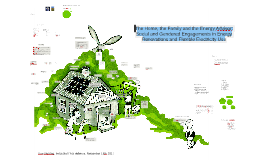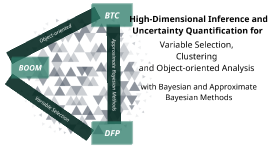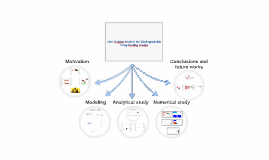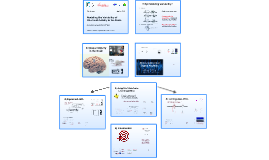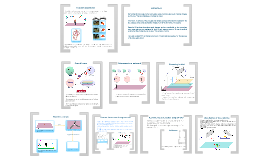PhD defense
Transcript: 1- Introduction 2- Theories and method 3- Chaterization and application 4-Conclusion 5- The connection Drug Delivery: -What ? -Why ? * The release ability of these two materials have been compared in term of using small molecules drug. However, silica nanotubes proved to be more suitable with large molecules drug. * This nanostructured tubes have been used with anti-cancer Doxorubicin and optimized the geometry for minimum energy using Hyperchem. Resultes were comparable with previously reported data. * Steric effects plays an important role in the loading efficency. Si-Ti-Sv * The efficiency of silica-titania sieves as bioactive materials as well as their potential to be a suitable nano-carrier have been examined by using a new anti-bacterial agent, Izohidrafural * Izohidrafural, the new antibiotic agent exhibited the highest antimicrobial efficiency, superior to the common drug Nitrofurantoin against the majority of E. coli strains, with average MIC of (4.68 µg/mL), followed by silica-titania sieves loaded with Izohidrafural. * The non-loaded silica-titanium sieves exhibited the highest antimicrobial activity against the gram-positive cocci. Nitrofurantoin Preparation technique Sol-Gel Sol-Gel Adjustments: Synergistic effect The synergistic effect might occur due to the fact that the Titanium dioxide, in form of anatase, in Si-Ti-Sv, has photocatalytic properties and thus the ability of creating reactive oxygen species (ROS)... Reported mechanism.G. Timmins et. al. (2006) The biological activity of isoniazid states (in Izo.) The presence of an oxidizing enzyme, KatG, the molecule is transformed into radical species BY TiO2 such as acyl, acylperoxo and pyridyl radicals... We may presume that TiO2 plays a role in activating Izohidrafural producing thus a synergistic effect... http://www.sigmaaldrich.com/technical-documents/articles/material-matters/mesoporous-materials.html Nanostructured silica MCM-41 The chemical structure for this drug is analogue to some extent with Nitrofurantoin, Urinary Tract Infections On the other hand the ORIENTATION of the calculated dipole moment, YELLOW ARROW favors the penetration of the molecule in polar cavities as it is for MCM-41. = slightly Higher Loading http://www.chromacademy.com/lms/sco5/10-Selecting-Reversed-Phase-Columns.html fChannel=6&fCourse=64&fSco=410&fPath=sco5/10-Selecting-Reversed-Phase-Columns.html Nitrofurazone Quantum Mechanics Izohidrafural Ibuprofen: Anti-inflammatory drug BASE MATERIAL -Adding Surfactant This method will be applied with other drugs For Detecting EE % Other Characterizations: *Three types of silica nanostructured materials have been prepared as drug carriers *The preparation technique follows the principals of sol-gel method, where the prepared silica materials were MCM-41, silica nanotubes and silica-titania sieves. *The obtained nanomaterials were characterized according to different considerations *The characterization methods were: SEM, TEM, EDAX, XRD, BET and FT-IR. *Silica-titania six different samples, according to different preparation medium and calcination conditions. *Silica nanotubes and MCM-41 were compared as a carrier materials for Ibuprofen with different encapsulation efficiencies and release profiles . The reason behind that proved to be related to the pore size of those two materials. General Atomic and Molecular Electronic Structure System (GAMESS) FTIR REFERENCES [1] L. P. Singh, S. K. Agarwal, S. K. Bhattacharyya, U. Sharma, S. Ahalawat, Nanomater. nanotechnol. 1 (2011) 44-51. [2] R. Stan, C. Ott, S. Rosca, A. Badanoiu, S.Stoleriu, G. Voicu, U.P.B. Sci. Bull., Series B 3 (2008) 1454-2331 [3] F. Kamar, A. Nechifor, M. Ridha, M. B. M. Al Tameemi, G. Nechifor, REV. CHIM. 66 (2015) 921-925. [4] Fruijtier-Polloth C., Toxicology 294 (2012) 61– 79. [5] D. Dykxhoorn, J. Lieberman, Cell 2 (2006) 231-5. [6] D. Dykxhoorn, D. Chowdhury, J. Lieberman, Dordrecht: Springer (2008) 299-329. [7] M. B. M. Al tameemi, Master thesis, EMU, university publications, Doi: http://hdl.handle.net/11129/1517 [8] L. Yan, X.Chen, Nanocrystalline Materials (2013) 221-268. [9] S. Ranghar, P. Sirohi, P. Verma, V. Agarwal, Braz. Arch. Biol. Technol 57 (2014) 209-222. [10] C. S. S. Kumar, WILEY-VCH Verlag GmbH & Co. KGaA, Weinheim (2006). ISBN: 3-527-31382-6 V [11] C. S. S. Kumar, WILEY-VCH Verlag GmbH & Co. KGa (2007). [12] I. Rahman, V. Padavettan, Journal of Nanomaterials (2012) 15. [13] W. Stober, A. Fink, J. Bohn, J. Coll. Int. Sci. 26 (1968) 62. [14] G. Bogush, C. Zukoski, J. Non‐Cryst. Sol. 104 (1988) 95. [15] J. Shi, L. Guo, F. Cui, X. Cui, Microporous and Mesoporous Materials 117 (2009) 609. [16] I. Rahman, P. Vejayakumaran, C. Chee, Ceramics International 32 (2006) 691. [17] Z. Wang, J. Zhao, X. Ding, K. Yu, Materials letters 59 (2005) 4013. [18] K. Ikari, K. Suzuki, H. Imai, Langmuir 22 (2006) 802. [19] Y. Han, J. Ying, Angewandte Chemie International Edition 44 (2004) 288–292. [20] T. Tan, S. Liu, Y. Zhang, M.-Y. Han, S. Selvan,






